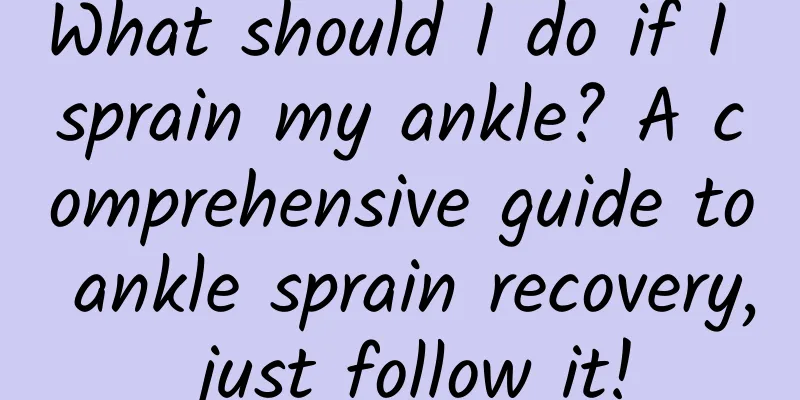What should I do if I sprain my ankle? A comprehensive guide to ankle sprain recovery, just follow it!

|
What should you do if you sprain your ankle? Don’t panic, experts from the Acupuncture and Rehabilitation Treatment Center of Hunan Provincial Hospital of Traditional Chinese Medicine will provide you with guidance. Some manual therapy is added to the treatment of lateral ankle sprains, such as graded joint mobilization, massage, and mobilization under weight-bearing and non-weight-bearing conditions to improve the patient's ankle dorsiflexion angle, proprioception, and weight-bearing tolerance. 1. Differential diagnosis - acute lateral ankle sprain When there is limited range of motion or loss of structural function, the Ottwa ankle rule is used to determine whether radiographs are needed to rule out ankle and/or foot fractures. Ottwa ankle criteria: X-rays are indicated if the patient has pain in the medial malleolus area, weight-bearing instability, or tenderness over the posterior lateral border (A) or medial medial malleolus (B); X-rays are indicated if the patient has midfoot pain, pain over the base of the fifth metatarsal (C), or tenderness over the navicular bone (D). 2. Rehabilitation Assessment Examination—Measurement of Activity Limitations and Participation Restrictions When reproducing symptoms of activity limitation and motor restriction in patients with recent or secondary lateral ankle injuries in the late acute phase, an objective and reproducible test method, such as the single-leg hop, is needed to assess lateral, diagonal, and change-of-direction movement. Check-up - physical injury When evaluating patients with acute or subacute lateral ankle sprains over a period of care, objective and reproducible testing of ankle swelling, ankle range of motion, talar translation and inversion, and single-leg balance should be included. 3. Phased Intervention 1. Intervention—Acute/Protected Mobility Phase—Early Supportive Weight-Bearing It is recommended that patients with acute lateral ankle sprains use an external brace and progressive weight bearing on the affected limb. The type of external brace and walker should be selected based on the severity of the injury, the stage of tissue healing, the level of protection required, the degree of pain, and patient preference. In more severe injuries, immobilization with a semirigid ankle brace or below-the-knee cast is recommended. 2. Intervention—Acute/Protective Mobilization Phase—Manual Therapy Manipulative therapies such as lymphatic drainage, active and passive soft tissue and joint mobilization, and anterior-posterior talar mobilization are used in patients with acute lateral ankle sprains to reduce swelling within a pain-free range of motion, improve pain-free range of motion of the ankle and foot, and help restore gait parameters to normal. 3. Interventions—Acute/Protected Mobility Phase—Physical Therapy Cryotherapy : repeated intermittent application of ice to relieve pain, reduce the need for analgesics, and improve weight-bearing after an acute ankle sprain. Diathermy : Pulsed short-wave therapy should be used to reduce edema and gait changes associated with acute ankle sprains. Electrotherapy : There is moderate-strength evidence both for and against the use of electrotherapy in the management of acute ankle sprains. Low-intensity laser therapy : There is moderate-strength evidence both for and against the use of low-intensity laser therapy in the management of acute ankle sprains. Ultrasound : Ultrasound should not be used in the management of acute ankle sprains. 4. Intervention—Acute/Protective Mobilization Phase—Therapeutic Exercise Patients with severe lateral ankle sprains should undergo a rehabilitation program that includes targeted therapeutic exercises (eg, passive mobilization, stretching). 5. Intervention - Progressive Loading/Sensory Motor Training Phase - Manual Therapy Some manual therapy is added to the treatment of lateral ankle sprains, such as graded joint mobilization, massage, and mobilization under weight-bearing and non-weight-bearing conditions to improve the patient's ankle dorsiflexion angle, proprioception, and weight-bearing tolerance. 6. Intervention – Progressive Loading/Sensorimotor Training Phase – Therapeutic Exercise and Activities Use therapeutic exercises and activities in the post-acute ankle sprain rehabilitation, such as weight-bearing functional exercises, single-leg balance activities using unstable planes, and postural control. 7. Intervention - Progressive Loading/Sensorimotor Training Phase - Sports Specific Training Use balance and sport-specific training to reduce the risk of recurrent ankle sprains in athletes. References for the above content: Impaired Ankle Stability and Movement Coordination: Lateral Ankle Ligament Sprain 2021 Revised American Physical Therapy Association Orthopaedic Section International Classification of Function, Disability and Health Related Clinical Practice Guidelines
(Edited by Wx) |
<<: It’s the 19th World Stroke Day. Save this popular science article about stroke!
>>: I strongly recommend that you eat this kind of pear by "sucking" it, it's amazing!
Recommend
What is the treatment for breast hyperplasia nodules
Breast hyperplasia nodules are a common disease a...
Bright red blood comes again one week after menstruation
Some friends found that their period came a week ...
Finger joint pain at 32 weeks of pregnancy
I believe that some women will experience finger ...
What to do if there is hydrops at the distal end of the fallopian tube
If hydrops of the distal fallopian tube occurs, i...
What are the must-check items for women's physical examination?
Nowadays, women pay more and more attention to th...
What should I pay attention to in the early stages of polycystic pregnancy?
Every woman looks forward to the birth of a new l...
False positive test paper picture
Nowadays, more and more unmarried pregnancies are...
Bleeding in women without menstruation
If a female friend does not have her menstruation...
How long will it take to give birth after mild uterine contractions?
Uterine contractions are a symptom before a pregn...
What should you pay attention to when protecting your pregnancy?
Pregnant women with threatened miscarriage, a his...
Can I eat peach gum during early pregnancy?
Bird's nest is a well-known nutritional suppl...
How to interpret the results of breast cancer immunohistochemistry
There are three unique features in breast cancer ...
How much does it cost to check the fallopian tubes?
In daily life, many women have problems with fert...
Hysteroscopic fallopian tube dredging experience
Fallopian tube obstruction is a more common gynec...
Pregnancy check-up process
For prenatal check-up, an ultrasound should be do...









